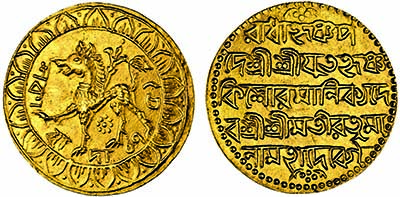The Exceptional Second Auction of the Nicholas Rhodes Collection of Coins of North East India

SPINK LONDON | This September, Spink are pleased to announce, will see the second auction of the magnificent collection of Nicholas Rhodes' Coins of North East India. The sale will take place on the 27th in London, and is brimming with some of the finest coins of this region. Spink are thrilled to be handling such a stunning collection amassed over a lifetime of passion and dedication to numismatics. The catalogue itself is sure to become a reference work for numismatic enthusiasts to come as it documents some of the most interesting social movements from medieval Bangal, Tripura, Cooch Behar, Manipur, Assam and Jaintiapur.
Nick Rhodes started to collect coins from an early age and as a seven year old was first taken to AH Baldwin & Sons, receiving excellent guidance from the late Albert Baldwin. In 1962, Nick started collecting oriental coins, particularly the coins of Nepal, which at this time presented the opportunity to build a meaningful collection and provided a fertile field for original research. Over the years he made many journeys to India, Nepal and Bhutan, where he had a large number of friends and contacts.
The culture of the north-eastern states of India is very distinct from that of the rest of India as from the fifteenth century they can be linked to the spread of Brahmanical religion from the Ganga valley. In order to smooth the conversion from tribal religions to the new order, the Brahmins sometimes explained how certain important tribal deities could be identified as Hindu deities. The familiar tribal iconography could thus be seamlessly retained and merely translated into the Hindu context by means of the Sanskrit language. As part of the ceremonies associated with the new Hinduised state, expensive rituals would be performed, and naturally the Brahmins would benefit from offerings and donations. The Brahmins later realised that it would be in their interests if these donations could be in portable assets, such as precious metals, and for this reason they encouraged the striking of coins. On the occasion of important ceremonies, such as the installation of a new king, the Brahmins dictated that silver and gold coins ought to be struck in the name of the new ruler with appropriate religious invocations celebrating the date of the event.
Judging from the evidence of coins, the first tribal chief to be converted into a Hinduised state was Ratna-pha of Tripura, who assumed the Hindu name of Ratna Manikya. His coins are all dated Śaka 1386 (=AD 1464), which must have been a pivotal date in the transformation process. They are all of silver, of the same weight standard (c.10.5g) as the contemporary coins of the Bengal Sultanate, and most show a lion on one side. Although this same lion had appeared on some coins of Nasir-ud-din Mahmud Shah of Bengal (see lot 3), in the case of Tripura it was probably intended as an appropriate royal insignia. In Hindu iconography the lion, represents the vehicle of Durga, so the religious invocations to Lord Shiva and his consort on the coins were also appropriate. On lot 19, a grotesque human-faced winged dragon appears, which has been interpreted as a unique representation of the Hindu deity, Narasimha, but would once have probably been instantly recognised by the tribal community as a powerful local deity, whose memory is now lost. This coin is extremely fine, and probably unique, its like has never been offered at auction before.
 |
Lot 19, estimated: £5,000-10,000
As Ratna Manikya was the first ruler of Tripura to issue coins much of his currency appear to be experimental in nature. Much of his standard currency reflected the time he spent at Gaur, an area ruled by the Bengal Sultans, and mirrors the coinage they were producing at the time of his visit. However this Tanka appears to be of entirely local inspiration. The human faced winged dragon being a version of the Hindu god Narasimha, the fearsome lion incarnation of the god Vishnu. The obverse depicts a lion that was to become the standard emblem on the majority of coins of Tripura from that date onwards. As this is the first and only time such a coin has been offered to the market it is likely to be hotly contested among collectors of this series.
Another unique feature of the coins of Tripura, is that they usually also give the name of the queen. Such consistent mention of females is unprecedented anywhere in South Asia, and clearly shows that the queen must have played an important part in the religious rituals of the Kingdom. Interestingly, centuries later the practice of naming queens was maintained as can be seen from lot 143, a particularly beautiful gold Mohur of Krishna Kishora Manikya (1830-50) citing Queen Ratna Mala. Krishna Kishora Manikya struck coins in the names of six queens. Those citing Queen Ratna Mala are the least rare while those citing the other queens are all extremely rare. A fantastic coin sure to set the room furiously bidding as it is extremely fine and of the highest rarity.
 |
Lot 143, estimated: £10,000-15,000
For more information about the sale or book enquiries, please contact Barbara Mears:
Tel: +44 (0)20 7563 4045 | Email: [email protected]
SPINK LONDON | 69 Southampton Row | Bloomsbury | London | WC1B 4ET
About Spink
Spink is the world's leading auctioneer of stamps, coins, banknotes, medals, bonds & shares, autographs, books and wine. Since its foundation in 1666, the Spink name has become synonymous with tradition, experience and integrity. Holder of royal warrants and numerous records for prices achieved at auction, Spink offers an unparalleled range of services to collectors worldwide. Headquartered in London, with offices in New York, Hong Kong, Singapore and Switzerland, Spink holds over 70 auctions a year. Catalogues can be accessed through the Spink website (www.spink.com) or via the Spink App for iPhone and iPad.



